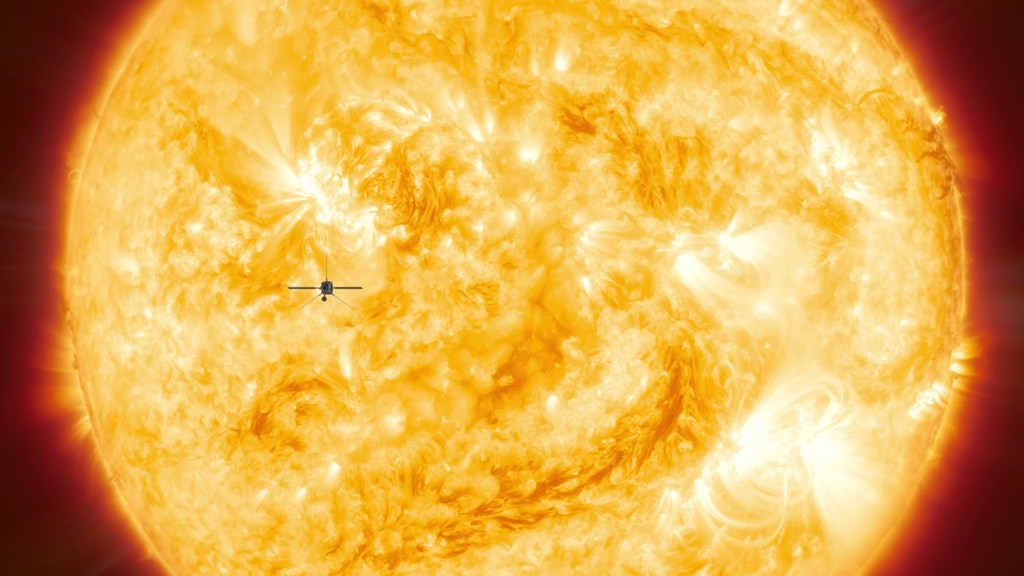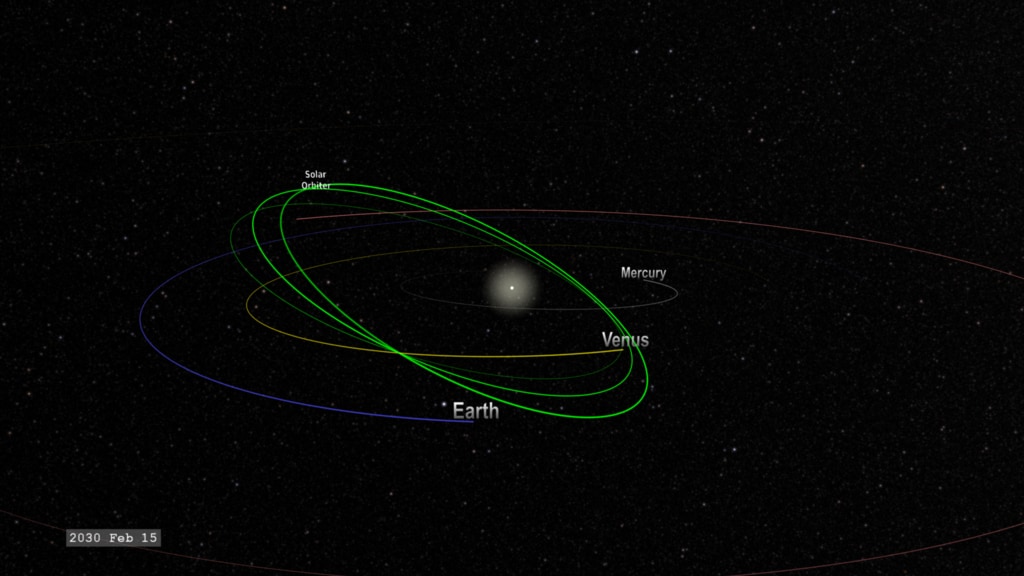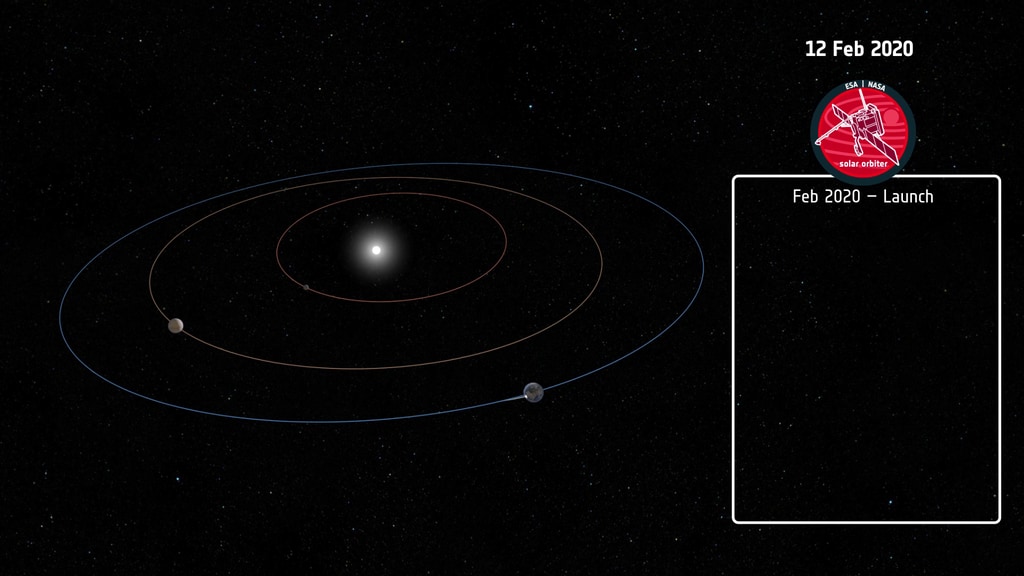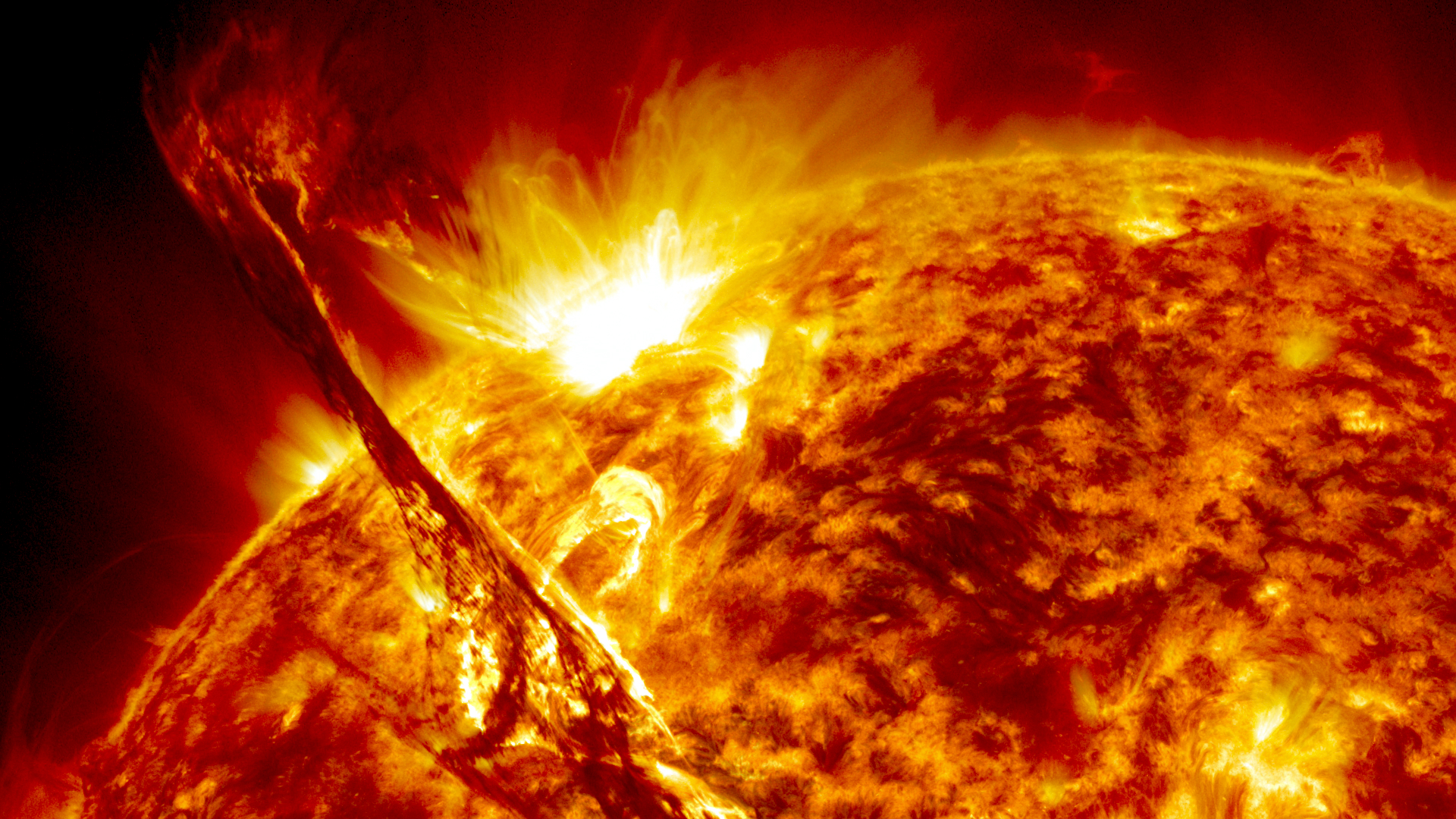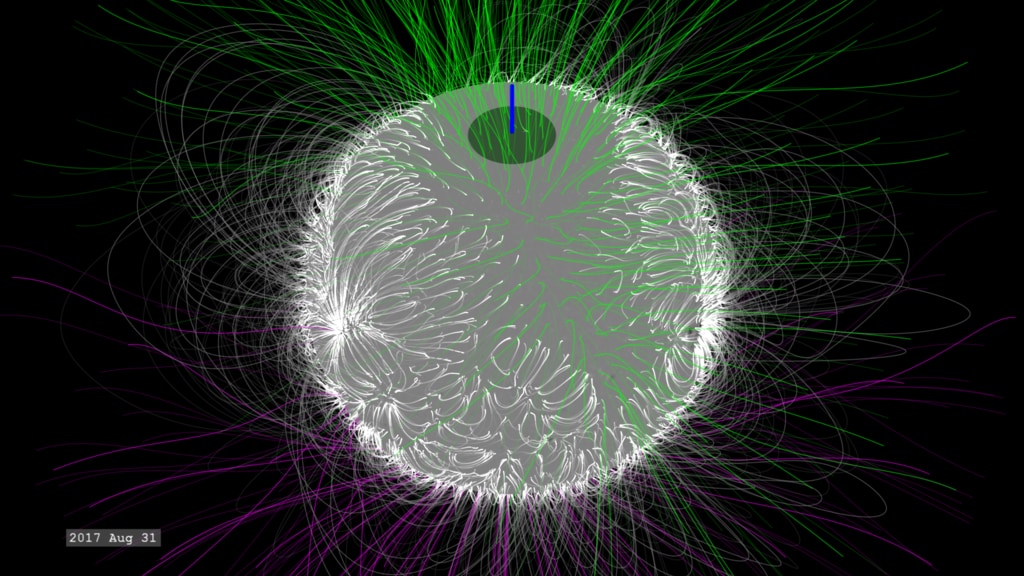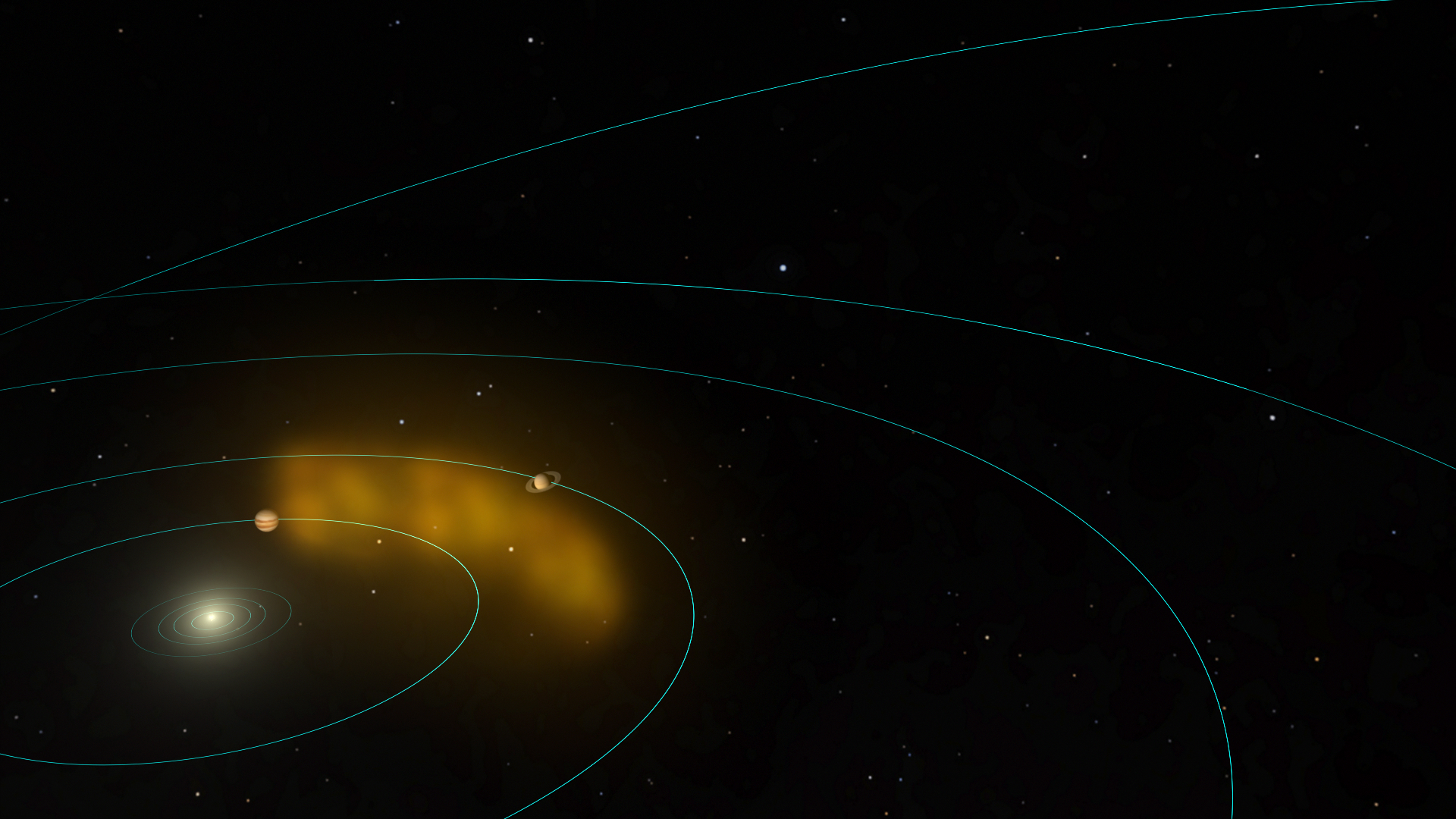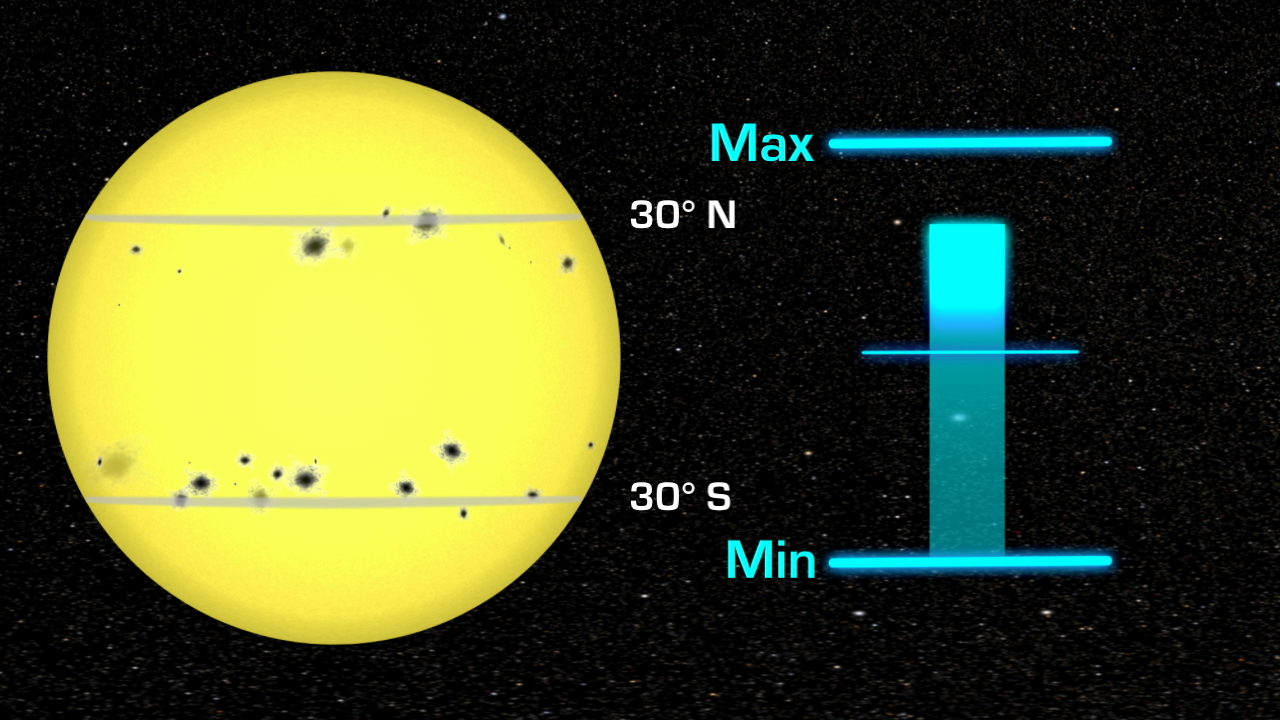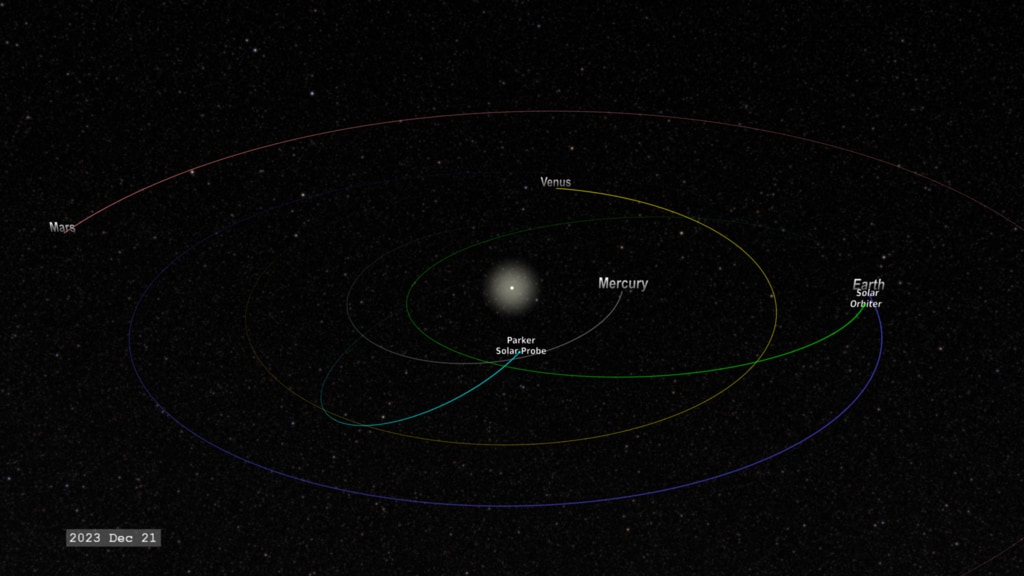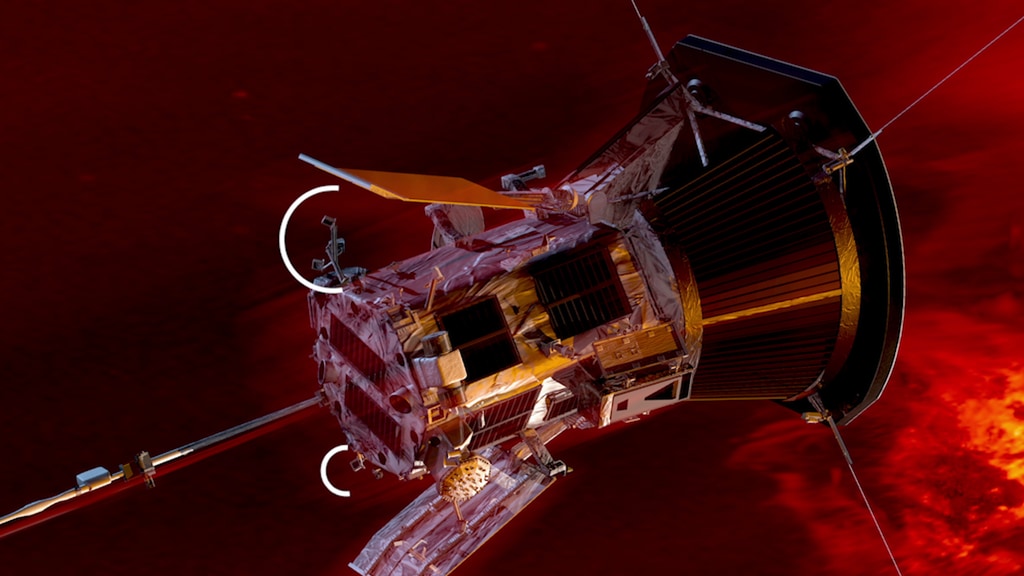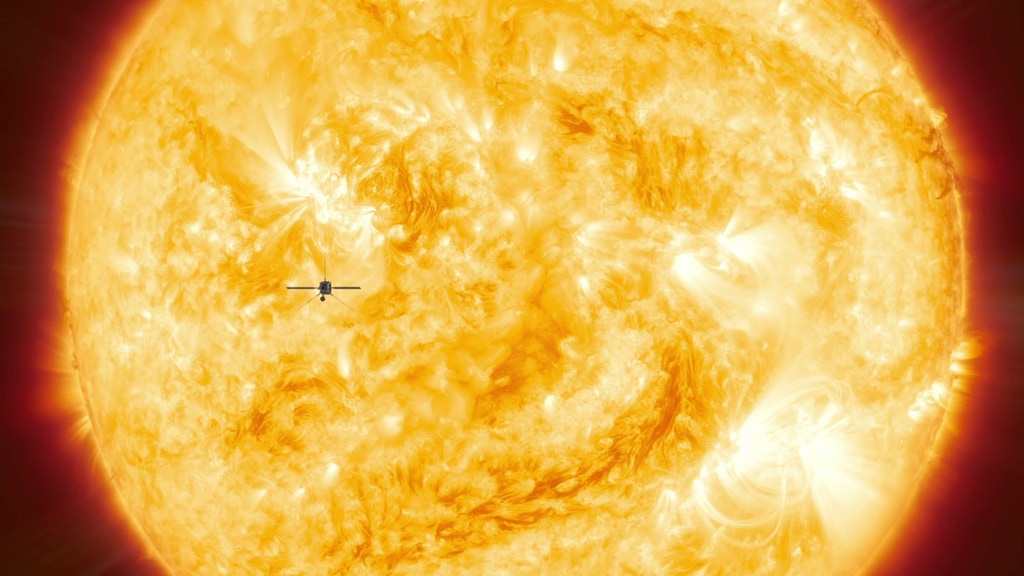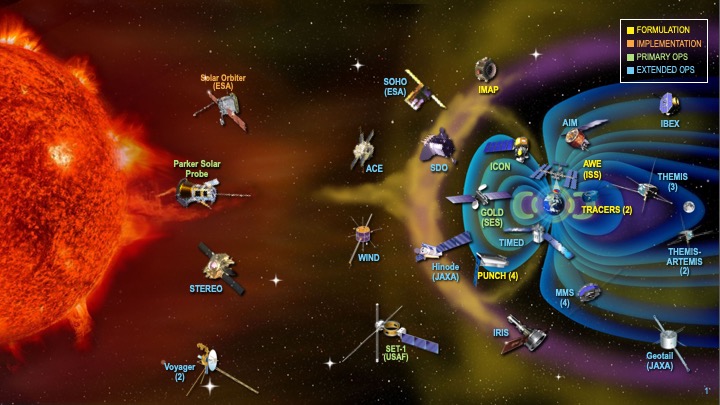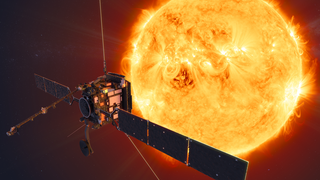Solar Orbiter
Overview
As the main driver of space weather, it is essential to understand the behavior of the Sun to learn how to better safeguard our planet, space technology and astronauts. Solar Orbiter will study the Sun, its outer atmosphere and what drives the constant outflow of solar wind which affects Earth. The spacecraft will observe the Sun's atmosphere up close with high spatial resolution telescopes and compare these observations to measurements taken in the environment directly surrounding the spacecraft – together creating a one-of-a-kind picture of how the Sun can affect the space environment throughout the solar system.
Solar Orbiter is a joint mission between NASA and the European Space Agency (ESA). It launched on Feb. 9, 2020, at 11:03 p.m. EST on a United Launch Alliance Atlas V 411 rocket from Space Launch Complex 41 at Cape Canaveral. NASA’s Launch Services Program managed the launch.
For more information on the Solar Orbiter mission, visit: https://sci.esa.int/web/solar-orbiter/home
Produced Videos
Solar Orbiter Trailer - Videos in English and Spanish
Go to this pageMusic: Find Her by Yuri SazonoffAnimation by ESA/ATG MedialabWatch this video on the NASA Goddard YouTube channel.Complete transcript available. || SolO_Trailer.00_00_48_09.Still001.jpg (1920x1080) [760.6 KB] || SolO_Trailer.00_00_48_09.Still001_searchweb.png (180x320) [123.9 KB] || SolO_Trailer.00_00_48_09.Still001_thm.png (80x40) [8.2 KB] || SolO_Trailer_EnglishV2.mov (1920x1080) [819.6 MB] || SolO_Trailer_EnglishV2.mp4 (1920x1080) [88.9 MB] || SolO_Trailer_EnglishV2.webm (1920x1080) [10.0 MB] || SolO_Trailer_EnglishV2Transcripts.en_US.srt [237 bytes] || SolO_Trailer_EnglishV2Transcripts.en_US.vtt [249 bytes] ||
New Mission Will Take First Peek at Sun’s Poles
Go to this pageA new spacecraft is journeying to the Sun to snap the first pictures of the Sun’s north and south poles. Solar Orbiter, a collaboration between ESA (the European Space Agency) and NASA will have its first opportunity to launch from Cape Canaveral on Feb. 7, 2020, at 11:15 p.m. EST. Launching on a United Launch Alliance Atlas V rocket, the spacecraft will use Venus’ and Earth’s gravity to swing itself out of the ecliptic plane — the swath of space, roughly aligned with the Sun’s equator, where all planets orbit. From there, Solar Orbiter's bird’s eye view will give it the first-ever look at the Sun's poles.Read more: https://www.nasa.gov/feature/goddard/2020/new-mission-will-take-first-peek-at-sun-s-poles ||
Solar Orbiter Imagery
Solar Orbiter - ESA Animations
Go to this pageSolar Orbiter is an European Space Agency (ESA) mission with strong NASA participation. Its mission is to perform unprecedented close-up observations of the Sun and from high-latitudes, providing the first images of the uncharted polar regions of the Sun, and investigating the Sun-Earth connection. ||
Solar Orbiter - NASA Animations
Go to this pageSolar Orbiter is an international cooperative mission between the European Space Agency and NASA that addresses a central question of heliophysics: How does the Sun create and control the constantly changing space environment throughout the solar system? The Sun creates what’s known as the heliosphere — a giant bubble of charged particles and magnetic fields blown outward by the Sun that stretches more than twice the distance to Pluto at its nearest edge, enveloping every planet in our solar system and shaping the space around us. To understand it, Solar Orbiter will travel as close as 26 million miles from the Sun, inside the orbit of Mercury. There, it will measure the magnetic fields, waves, energetic particles and plasma escaping the Sun while they are in their pristine state, before being modified and mixed in their long journey from the Sun. ||
Solar Orbiter Orbit Views (Pre-launch and Post-launch versions)
Go to this pageOblique view of Solar Orbiter orbit evolution, based on the actual launch date to the nominal end-of-mission. || SolarOrbiter.side.HAE.AU.clockSlate_CRTT.HD1080i.03667_print.jpg (1024x576) [87.7 KB] || SolarOrbiter.side.HAE.AU.clockSlate_CRTT.HD1080i.03667_searchweb.png (320x180) [69.3 KB] || SolarOrbiter.side.HAE.AU.clockSlate_CRTT.HD1080i.03667_web.png (320x180) [69.3 KB] || SolarOrbiter.side.HAE.AU.clockSlate_CRTT.HD1080i.03667_thm.png (80x40) [4.0 KB] || SolarOrbiter.side.postlaunch.HD1080i_p30.mp4 (1920x1080) [68.0 MB] || OrbitObliqueView.postlaunch (1920x1080) [0 Item(s)] || SolarOrbiter.side.postlaunch.HD1080i_p30.webm (1920x1080) [15.2 MB] || OrbitObliqueView.postlaunch (3840x2160) [0 Item(s)] || SolarOrbiter.side.postlaunch_2160p30.mp4 (3840x2160) [194.6 MB] ||
Solar Orbiter's Orbit
Go to this pageAn animation showing the trajectory of Solar Orbiter around the Sun, highlighting the gravity assist manoeuvres that will enable the spacecraft to change inclination to observe the Sun from different perspectives.During the initial cruise phase, which lasts until November 2021, Solar Orbiter will perform two gravity-assist manoeuvres around Venus and one around Earth to alter the spacecraft’s trajectory, guiding it towards the innermost regions of the Solar System. At the same time, Solar Orbiter will acquire in situ data and characterise and calibrate its remote-sensing instruments. The first close solar pass will take place in 2022 at around a third of Earth’s distance from the Sun.The spacecraft’s orbit has been chosen to be ‘in resonance’ with Venus, which means that it will return to the planet’s vicinity every few orbits and can again use the planet’s gravity to alter or tilt its orbit. Initially Solar Orbiter will be confined to the same plane as the planets, but each encounter of Venus will increase its orbital inclination. For example, after the 2025 Venus encounter it will make its first solar pass at 17º inclination, increasing to 33º during a proposed mission extension phase, bringing even more of the polar regions into direct view. ||
Solar Orbiter Graphics
Go to this pageCredit: ESA/ATG medialab || ESA_Solo_FacingTheSun_poster.jpg (7016x9933) [12.0 MB] || Credit: ESA/ATG medialab || ESA_Solo_Facing_the_Sun_2_horiz.jpg (3508x2480) [7.6 MB] || Credit: ESA/ATG medialab || ESA_Solo_Facing_the_Sun_2_vertical.jpg (2480x3508) [8.1 MB] || Credit: ESA/ATG medialab || ESA_Solo_Facing_the_Sun_3.jpg (9933x7016) [8.4 MB] ||
The Sun
SDO Anniversary Series
Go to this pageThe sun is always changing and NASA's Solar Dynamics Observatory is always watching. Launched on Feb. 11, 2010, SDO keeps a 24-hour eye on the entire disk of the sun, with a prime view of the graceful dance of solar material coursing through the sun's atmosphere, the corona.Year 1 ||
The Solar Polar Magnetic Field
Go to this pageFrom our single vantage point of Earth, our view of the Sun is never complete. While the far-side of the Sun eventually rotates into view, coverage of the Sun's polar regions is never satisfactory as perspective effects either completely block our view or create a distorted view. We must often resort to computer modeling of these solar polar regions.This visualization presents the Potential Field Source Surface (PFSS) magnetic field model based on solar observations covering the years 2017-2019. One version also presents the 'hole' in our measurements of the solar polar region. The region oscillates in size over the course of the year due to the changing perspective created by the tilt of Earth's orbital plane with the solar equator. In this region, researchers must resort to approximations to build a more complete view of the solar magnetic field.Why is the solar magnetic field in this region important? Because the combined with the outgoing flow of the solar wind, the magnetic field lines from the polar regions curve up, and then back down to near the Sun's equatorial plane, which is still fairly close to the orbital plane of Earth and other planets in our solar system. This gives the Sun's polar magnetic field a significant influence on the space weather impacting Earth and crewed and uncrewed assets around the solar system. ||
Coronal Mass Ejections (CMEs) Blast Their Way Through the Solar System
Go to this pageA coronal mass ejection erupts from the Sun and propagates out through the Solar System. Along the way it is detected by the spacecraft at Jupiter and Saturn. Eventually it is detected by the two Voyager spacecraft beyond the orbit of Pluto. This animation is based on CMEs produced during the Halloween storms of 2003. It is an update to a previous animation. ||
The Solar Cycle
Go to this pageThe number of sunspots increases and decreases over time in a regular, approximately 11-year cycle, called the sunspot cycle. The exact length of the cycle can vary. It has been as short as eight years and as long as fourteen, but the number of sunspots always increases over time, and then returns to low again. More sunspots mean increased solar activity, when great blooms of radiation known as solar flares or bursts of solar material known as coronal mass ejections (CMEs) shoot off the sun's surface. The highest number of sun spots in any given cycle is designated "solar maximum," while the lowest number is designated "solar minimum." Each cycle, varies dramatically in intensity, with some solar maxima being so low as to be almost indistinguishable from the preceding minimum. Sunspots are a magnetic phenomenon and the entire sun is magnetized with a north and a south magnetic pole just like a bar magnet. The comparison to a simple bar magnet ends there, however, as the sun's interior is constantly on the move. By tracking sound waves that course through the center of the sun, an area of research known as helioseismology, scientists can gain an understanding of what's deep inside the sun. They have found that the magnetic material inside the sun is constantly stretching, twisting, and crossing as it bubbles up to the surface. The exact pattern of movements is not conclusively mapped out, but over time they eventually lead to the poles reversing completely. The sunspot cycle happens because of this poles flip — north becomes south and south becomes north—approximately every 11 years. Some 11 years later, the poles reverse again back to where they started, making the full solar cycle actually a 22-year phenomenon. The sun behaves similarly over the course of each 11-year cycle no matter which pole is on top, however, so this shorter cycle tends to receive more attention. ||
Magnetospheres of our Solar System
Go to this pageA magnetosphere is the magnetic field shields a planet against the Sun's dangerous radiation. Not all magnetospheres are alike. This animation depicts the unique magnetospheres around Earth, Mars, and Jupiter. To demonstrate their strength, each planet's magnetosphere receives a direct hit from a coronal mass ejection (CME) - a cloud of dense radiation and magnetic field from the Sun. The impact of the CME on the planet depends on the strength of the magnetosphere. On Mars, the magnetosphere is weak and patchy, resulting in some loss of the planet's atmosphere. At Earth, the magnetosphere acts as a buffer, deforming from the impact, but protecting the planet. For Jupiter, the punch of the CME is barely felt by the massive magnetic field. ||
Excerpt from "Dynamic Earth"
Go to this pageA giant explosion of magnetic energy from the sun, called a coronal mass ejection, slams into and is deflected completely by the Earth's powerful magnetic field. The sun also continually sends out streams of light and radiation energy. Earth's atmosphere acts like a radiation shield, blocking quite a bit of this energy.Much of the radiation energy that makes it through is reflected back into space by clouds, ice and snow and the energy that remains helps to drive the Earth system, powering a remarkable planetary engine — the climate. It becomes the energy that feeds swirling wind and ocean currents as cold air and surface waters move toward the equator and warm air and water moves toward the poles — all in an attempt to equalize temperatures around the world.A jury appointed by the National Science Foundation (NSF) and Science magazine has selected "Excerpt from Dynamic Earth" as the winner of the 2013 NSF International Science and Engineering Visualization Challenge for the Video category. This animation will be highlighted in the February 2014 special section of Science and will be hosted on ScienceMag.org and NSF.govThis animation was selected for the Computer Animation Festival's Electronic Theater at the Association for Computer Machinery's Special Interest Group on Computer Graphics and Interactive Techniques (SIGGRAPH), a prestigious computer graphics and technical research forum. This is an excerpt from the fulldome, high-resolution show 'Dynamic Earth: Exploring Earth's Climate Engine.' The Dynamic Earth dome show was selected as a finalist in the Jackson Hole Wildlife Film Festival Science Media Awards under the category "Best Immersive Cinema - Fulldome". ||
Solar Orbiter & Parker Solar Probe
Parker Solar Probe and Solar Orbiter Trajectories
Go to this pageThis visualization opens near Earth for the launch of Parker Solar Probe August 12, 2018. Then the camera moves around the Sun to match of with Earth again for the launch of Solar Orbiter in 2020. After that, the camera moves in a slow drift around the Sun as the orbits evolve. The Parker Solar Probe orbit fades out after the nominal end of mission in 2025. This version has longer orbit trails to better view orbit changes, and the red along the orbits indicate the nominal science operations portions of the missions. || ParkerAndSolarOrbiter.InnerTourDeluxe.HAE.AU.clockSlate_EarthTarget.HD1080i.02000_print.jpg (1024x576) [100.7 KB] || DeluxeTour (1920x1080) [0 Item(s)] || ParkerAndSolarOrbiter.InnerTourDeluxe.HD1080i_p30.webm (1920x1080) [17.6 MB] || ParkerAndSolarOrbiter.InnerTourDeluxe.HD1080i_p30.mp4 (1920x1080) [179.8 MB] || DeluxeTour (3840x2160) [0 Item(s)] || ParkerAndSolarOrbiter.InnerTourDeluxe_2160p30.mp4 (3840x2160) [489.0 MB] || ParkerAndSolarOrbiter.InnerTourDeluxe.HD1080i_p30.mp4.hwshow [270 bytes] || ParkerAndSolarOrbiter.InnerTourDeluxe_2160p30.mp4.hwshow [211 bytes] ||
Parker Solar Probe Science Briefing - Visual Resources
Go to this pageJuly 20, 2018 - Live from NASA Kennedy - 1:00 p.m. ESTHosted by Karen Fox - Heliophysics Communications Lead, NASA Goddard/NASA HQSpeakers:Nicola Fox - Parker Solar Probe Project Scientist, The Johns Hopkins University Applied Physics LabAlex Young - Solar Scientist from NASA GoddardThomas Zurbuchen - Associate Administrator for the Science Mission Directorate at NASABetsy Congdon - Thermal Protection System Engineer at The Johns Hopkins University Applied Physics Lab ||
Media Events
Solar Orbiter Science Press Briefing
Go to this pageNASA and the European Space Agency (ESA) will present Solar Orbiter, the ESA/NASA mission to the Sun, during a science press briefing on Friday, Feb. 7. 2020, at 2.30 p.m. EST. Solar Orbiter will observe the Sun with high spatial resolution telescopes and capture observations in the environment directly surrounding the spacecraft to create a one-of-a-kind picture of how the Sun can affect the space environment throughout our solar system. The spacecraft also will provide the first-ever images of the Sun’s poles and the never-before-observed magnetic environment there, which helps drive the Sun’s 11-year solar cycle and its periodic outpouring of solar storms.The teleconference audio will stream live at:https://www.nasa.gov/liveParticipants include:European Space Agency• Daniel Müller, Solar Orbiter Project Scientist• Günther Hasinger, Director of ScienceNASA• Nicky Fox, Heliophysics Division Director, NASA HQ• Thomas Zurbuchen, Associate Administrator for the Science Mission Directorate, NASA HQ ||
The Countdown is on for Launch of NASA’s Next Mission to Face the Sun Live Shots
Go to this pageB-roll and canned interviews will be added by Thursday at 4:00 p.m. ESTSolar Orbiter Will Give Humanity Its First Close-Up Look At The Sun’s Poles || screengrab.png (2306x724) [2.8 MB] || screengrab_print.jpg (1024x321) [99.4 KB] || screengrab_searchweb.png (320x180) [126.2 KB] || screengrab_thm.png (80x40) [8.4 KB] ||
Solar Orbiter Media Telecon
Go to this pageNASA and ESA scientists will present Solar Orbiter, the ESA/NASA collaboration soon to start its journey to the Sun, during a media teleconference on Monday, Jan. 27, 2020 at 2 p.m. EST. Mission experts will discuss Solar Obiter’s uniquely tilted orbit, how the mission will capture the first images of the Sun’s North and South poles, and its ability to tackle major solar mysteries with its comprehensive suite of ten different instruments. The teleconference audio will stream live at:https://www.nasa.gov/liveParticipants include:•Nicola Fox, director of the Heliophysics Division in the Science Mission Directorate at NASA Headquarters in Washington•Chris St. Cyr, former NASA project scientist for the mission at NASA Goddard•Yannis Zouganelis, ESA deputy project scientist for Solar Orbiter at the European Space Astronomy Centre in Madrid, Spain•Anne Pacros, ESA Mission and Payload Manager ||
NASA y ESA presentarán la última misión al Sol en una teleconferencia de prensa
Go to this pageCientíficos de la NASA y la Agencia Espacial Europea (ESA, por sus siglas en inglés) presentarán la misión Solar Orbiter, una colaboración de la ESA/NASA que está a punto de iniciar su viaje hacia el Sol, durante una teleconferencia de prensa en español el lunes 27 de enero de 2020 a las 11 am EST. Tres expertos de la misión describirán la órbita inclinada única del Solar Orbiter, cómo la misión capturará las primeras imágenes de los polos norte y sur del Sol, y la capacidad de la nave para abordar los principales misterios solares con su completo conjunto de diez instrumentos. El audio de la teleconferencia se retransmitirá en vivo por: https://www.nasa.gov/live· Teresa Nieves-Chinchilla, científica adjunta de proyecto por parte de la NASA para el Solar Orbiter, Centro de Vuelo Espacial Goddard de la NASA en Greenbelt, Maryland, EE.UU.· Luís Sanchez, jefe de desarrollo de operaciones científicas para el Solar Orbiter, Centro Europeo de Astronomía Espacial de la ESA en Madrid, España.· Yaireska Collado-Vega, líder del equipo de pronóstico de la meteorología espacial en el Centro de Modelos Coordinado por la Comunidad, Centro de Vuelo Espacial Goddard de la NASA en Greenbelt, Maryland, EE.UU. ||

![VideoWatch this video on the NASA Goddard YouTube channel.Music credits: “Oxide” and “Virtual Tidings” by Andrew Michael Britton [PRS], David Stephen Goldsmith [PRS]; “Progressive Practice” by Emmanuel David Lipszc [SACEM], Franck Lascombes [SACEM], Sebastien Lipszyc [SACEM]; “Political Spectrum” by Laurent Dury [SACEM} from Universal Production MusicComplete transcript available.](/vis/a010000/a013500/a013527/13537_SolarOrbiterOverview_YouTube.00725_print.jpg)
